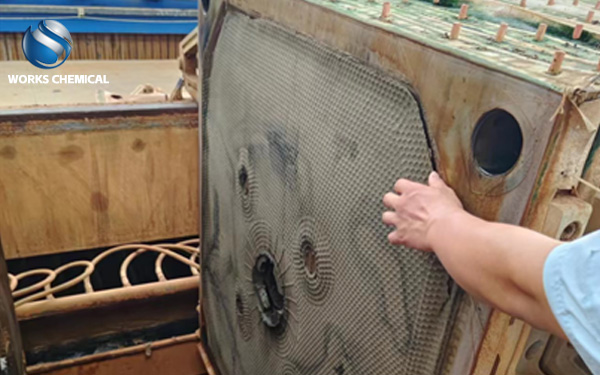
For the problems of mud cake pressing and low filtering efficiency, combined with industry practice and technical information found, Shijun Xiaobian will organize the following systematic solutions for you:

First, chemical conditioning optimization
Precise selection
Inorganic sludge: The preferred choice of iron salt conditioner (such as FeCl₃), the destruction of colloidal structure of high efficiency, low cost.
Organic sludge: cationic polyacrylamide (CPAM) is used to form dense floc through electrical neutralization + bridging.
Complex sludge: A new type of conditioner is recommended, which has the function of breaking the wall and releasing intracellular water and bridging dehydration.
Dosage control
Experimental confirmation: Take the on-site sludge for beaker experiment, observe the floc formation and settling rate, and determine the best dosing ratio.
Dynamic adjustment: Adjust the dosage in real time according to the change of sludge moisture content and pH value to avoid excessive clogging of filter cloth.
Two, equipment upgrading
Filter cloth system optimization
Selection and matching: According to the size of the sludge particles, select the filter cloth aperture (such as 0.2-0.5mm filter cloth for domestic sludge).
Automatic cleaning: Install high pressure spray system, set automatic cleaning every 2 hours, restore the permeability of the filter cloth.
Hydraulic control system upgrade
Stage press: The three-stage press process is adopted, the initial pressure is 0.8MPa and dehydration is 30 minutes, the secondary press is 1.5MPa and dehydration is 20 minutes, and the final press is 2.0MPa and dehydration is 10 minutes.
Pressure holding optimization: Set the pressure holding time during the press stage to ensure that the water is fully discharged.
Three, process parameter adjustment
Pretreatment and reinforcement
Flocculation precipitation: Increase the residence time of the sludge thickening tank to 4 hours to ensure that the agent fully reacts with the sludge.
pH regulation: the pH of the sludge is adjusted to 6-8 by adding acid/alkali to improve the efficiency of the conditioner.
Operation mode optimization
Feed control: the "low pressure - slow feed" mode is adopted to avoid sludge impact on the filter cloth.
Press strategy: The use of "air pressure filter" technology, in the press stage to inject compressed air, improve the clay biscuit degree of 5%-8%.
Four, intelligent management
On-line monitoring
Install moisture content sensor, pressure sensor, real-time feedback mud cake moisture content and equipment operating status.
AI Optimization system
Deploy the sludge dewatering expert system to automatically adjust the dosage of agent, press pressure and other parameters according to real-time data.
Five Typical case reference
A municipal sludge treatment plant upgrade case:
Original problem: the moisture content of mud cake is 82%, and the filter cloth is blocked in 3 days.
Reform measures:
Replace with a new conditioner, the dosage is reduced by 40%.
Upgrade the automatic cleaning filter cloth system with a three-stage press module.
Effect:
The moisture content of mud cake is reduced to 58%, and the service life of filter cloth is extended to 30 days.
Daily processing capacity increased by 60%, and comprehensive cost decreased by 35%.
Implementation Suggestions:
The sludge property analysis (solid content, organic matter content, particle size distribution) is given priority to provide a basis for drug selection.
Select 2-3 suppliers for laboratory comparison, focusing on the three major indicators of mud cake moisture content, pharmaceutical cost and filter cloth clogging rate.
The transformation is implemented in stages: first optimize the reagent + cleaning system, then upgrade the press module, and finally deploy an intelligent monitoring system.
Through the above systematic optimization, the mud cake moisture content can be reduced to less than 60%, the filtration efficiency can be increased by more than 50%, and the equipment failure rate and operation and maintenance costs can be reduced.